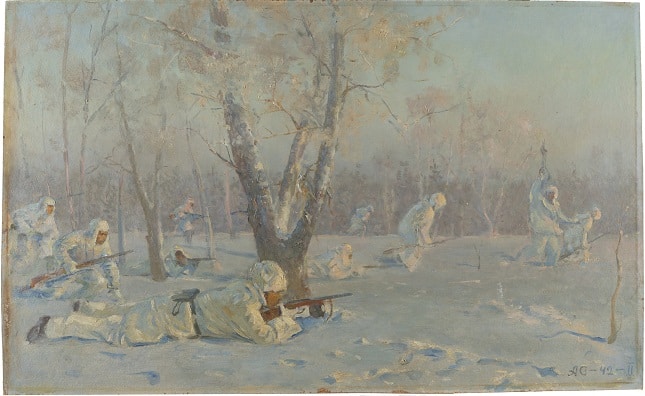Reconnaissance Attack, a gift from Stalin’s Foreign Minister Molotov to U.S. Ambassador Joseph B. Davies, is the first new work added to the Davies Collection since 1938
Madison, Wis. – While serving as United States Ambassador to the Soviet Union in 1937, Joseph B. Davies collected more than 80 Soviet Realist paintings of the 1920s and 30s. The canvasses represent a wide variety of subject matter – history painting, landscapes, genre scenes and profiles of factories and industry – and depict the extensive geographic reach of the USSR. Davies later purchased over 20 religious icons, which, together with the paintings, were donated to his alma mater, the University of Wisconsin Madison, in 1937 and 1938. The Davies Collection is one of the Chazen Museum of Art’s many unique collections that showcase unusual slices of global art history.
In 2018, the Chazen added a new work, Reconnaissance Attack by Latvian artist Arkadaii Soloviev, to the Davies Collection. The first addition to the Davies Collection since the collection’s establishment, the painting depicts Soviet troops with guns drawn moving through a snow-covered landscape. Reconnaissance Attack was given to Davies by Joseph Stalin’s Foreign Minister, Vyacheslav Molotov, in 1943. It remained in the Davies family until 2018, when the Chazen acquired it via public auction. Along with the painting and frame, the Chazen also acquired an original letter from Molotov to Davies describing the painting and other gifts offered from Stalin and Molotov to the Ambassador.
“Ambassador Davies was a fascinating person who played a key role in Franklin Delano Roosevelt’s efforts to maintain relations with the nascent Soviet Union,” said Katherine Alcauskas, chief curator at the Chazen. “He had unique access to Stalin and his administration, as the gift from Molotov illustrates. The Davies collection, along with this new acquisition, helps us explore the history of U.S. diplomatic relations with Russia and the world.”
The Conservation Center in Chicago worked to conserve Reconnaissance Attack, addressing mostly age-related damage to both the painting and its frame. A label on the back of the painting, written in Russian, was protected with Mylar encapsulation. The painting was cleaned, a layer of varnish was removed, and infill painting addressed areas of loss. The frame, composed of wood, compo, gesso and gold leaf, received a variety of treatments, including stabilization, selective re-casting using conservation-grade materials and inpainting/gilding for the nameplate.
Davies graduated from the University of Wisconsin in 1898, and from the Law school in 1901. Over the next decade, Davies rose in stature in Democratic politics, eventually becoming the Chair of the Wisconsin Democratic Party in 1907. As a supporter of President Woodrow Wilson, Davies was appointed chairman of the Commission of Corporations, now the Federal Trade Commission, from 1915-1916. After World War I, Davies accompanied President Wilson to the Versailles Peace Conference.
Davies was married to businesswoman-heiress Marjorie Merriweather Post, also a prominent collector of Russian art, from 1935-1955. From 1936-1938, under the presidency of Franklin Delano Roosevelt, Davies served as Ambassador to the Soviet Union, where he would cultivate friendships with the growing superpower and play an important role in building connections between the U.S. and the USSR. In May of 1945, the Soviet Union’s Supreme Soviet awarded Davies with the Order of Lenin. Davies went on to receive similar awards from France and Belgium and received the Medal of Merit from President Truman. Davies died in 1958.
“Thinking about the diplomatic challenges Davies faced is interesting in the context of today’s geopolitical landscape,” said Alcauskas. “By adding a new work to the Davies collection, we are excited to give our faculty a new lens through which to examine these works, which are utilized in multiple classes throughout the academic year.”
The Chazen, which celebrates its 50th anniversary in 2020, is experimenting with new ways to interpret and display its collection of more than 23,000 objects. Reconnaissance Attack is currently on view as part of the museum’s Faculty Exhibition 2020. The exhibition asks UW–Madison faculty to consider their work in conversation with the Chazen’s collection. Stephen Hilyard, professor of digital arts at UW–Madison, has created a video installation displayed in the gallery alongside both Reconnaissance Attack and other paintings from the Davies Collection. The installation features six video screens playing fragments of Hilyard’s three-channel experimental movie, Катюша (Katyusha). The film explores the complex history of Pyramiden, a planned community developed by the Soviet Union as the northernmost town on earth, and abandoned by in 1998. The installation will be on view through May 10.
ABOUT THE CHAZEN
The Chazen Museum of Art makes its home between two lakes on the beautiful campus of the University of Wisconsin–Madison. Within walking distance of the state capitol, it sits squarely in the heart of a vibrant college town. Featuring one of the best views on campus, an art-filled bridge connects the historic Elvehjem building, built in 1970, with the Chazen building, built in 2011. This connection represents both a physical and intellectual joining of human art history and the most dynamic artistic explorers of today.
With a permanent collection of more than 23,000 objects, from vessels of ancient Greece to prints by Kara Walker, the Chazen is the second largest museum in Wisconsin. Two expansive buildings encompass 163,000+ square feet, making it the largest collecting museum in the Big Ten. More than 100,000 visitors come through the Chazen’s doors each year to enjoy the permanent collection and special exhibitions. The Chazen is the most-open museum among its peers, with open hours from 8 a.m. to 8 p.m., seven days a week. Admission is free for all and includes programs for students, families and community members, all provided with the museum’s unique brand of Wisconsin hospitality.
More information, including the schedule of visiting exhibitions and events, can be found at www.chazen.wisc.edu.



